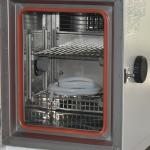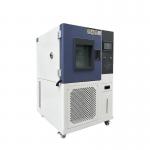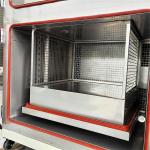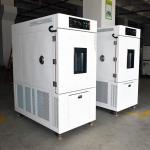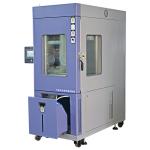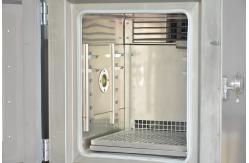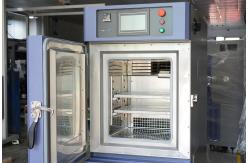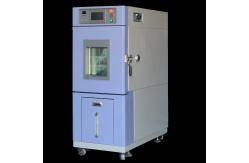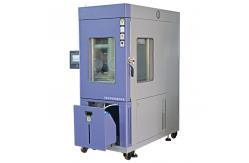In the current era of rapid technological development, the
automobile and parts industry is undergoing profound changes,
transitioning from traditional fuel vehicles to new energy
vehicles, with the trends of intelligence and connectivity becoming
increasingly prominent. During this process, product quality and
reliability have become the foundation for enterprises to stand
firm in the market. Automobiles and their parts need to withstand
the complex temperature and humidity environmental challenges
brought about by different regions and seasons during actual use.
The custom programmable temperature and humidity chamber emerges as
a timely solution. It provides the industry with the ability to
simulate various extreme and conventional temperature and humidity
scenarios, assisting enterprises in comprehensively controlling
product performance throughout the entire product life cycle, from
the initial R&D concept to large-scale production. This enables
them to meet the stringent market requirements and propel the
industry to new heights. - Ultra-wide Temperature Range Coverage: The test chamber can achieve an ultra-wide temperature adjustment
range from - 60°C to 180°C. This means that it can not only
simulate the extremely cold temperatures in the Arctic Circle,
subjecting automotive components such as batteries and rubber seals
to performance tests in near-extreme low temperatures to ensure
their normal operation in cold regions but also simulate the
high-temperature environment in the engine compartment. The
temperature of up to 180°C can be used to test the heat resistance
of components around the engine, such as the stability of plastic
intake manifolds and electronic sensors at high temperatures. The
temperature control accuracy can reach ±0.3°C, providing a solid
guarantee for precise testing.
- High-precision Humidity Regulation: The humidity adjustment range is between 10%RH and 98%RH, with an
accuracy control of ±2%RH. In a high-humidity environment, it can
simulate the rainy and humid seasons in southern China or the humid
climate in coastal areas to detect the anti-corrosion ability of
automotive metal components and the moisture-proof performance of
electronic devices. The low-humidity environment can simulate the
dry climate in desert areas to test the anti-cracking performance
of interior materials and the stability of some electronic
components sensitive to humidity.
- Construction of Complex Temperature and Humidity Curves: With the help of the advanced programming interface, users can
easily construct complex temperature and humidity change curves
according to actual needs. For example, simulate the dynamic
changes in battery temperature and interior humidity of an electric
vehicle under different driving modes. During the fast charging
mode, the battery temperature rises rapidly, and at the same time,
the operation of the vehicle's air conditioning system changes the
humidity. By setting the heating and cooling rates as well as the
humidity change rate, this process can be precisely simulated,
providing data support for the optimization of the battery thermal
management system and the vehicle interior environment control
system.
- Multi-stage and Multi-scenario Test Programs: It supports the creation of multi-stage test programs, and each
stage can be set with different temperature and humidity
parameters, durations, and change rates. For example, for the
durability test of automotive parts, a test program including
multiple stages such as high-temperature and high-humidity
accelerated aging, low-temperature cold start, and rapid
temperature and humidity alternation can be designed to simulate
various environmental scenarios that the parts may encounter
throughout the vehicle's life cycle and comprehensively evaluate
their performance changes.
- Optimized Internal Structure Design: The test chamber adopts an innovative air duct design and
internal layout to ensure uniform distribution of temperature and
humidity inside the chamber. The unique circulating air duct,
combined with an efficient fan, enables the temperature and
humidity uniformity to reach ±2°C (temperature) and ±5%RH
(humidity) when the chamber is unloaded, and it can also maintain a
minimal deviation range when loaded, avoiding inaccurate test
results caused by local environmental differences. At the same
time, the internal space is flexibly designed, and special sample
racks and fixing devices can be customized according to the size
and shape of automotive parts to ensure that the test samples are
fully and evenly exposed to the temperature and humidity
environment.
- Intelligent Multiple Safety Protection System: It is equipped with an intelligent multiple safety protection
device, including multiple protections such as over-temperature,
over-pressure, leakage, and water shortage. When the temperature
exceeds the set upper or lower limit by a certain threshold, the
over-temperature protection system will be activated immediately,
cutting off the heating or cooling power supply and triggering the
alarm device. The over-pressure protection can prevent damage to
the equipment caused by abnormal pressure. The leakage protection
can ensure the safety of the operators. The water shortage
protection ensures the normal operation of the humidification
system. In addition, it also has an intelligent door lock and door
opening warning function. When the test is running, if someone
tries to open the door, the system will issue an alarm and prevent
the door from opening to prevent the temperature and humidity from
getting out of control and the test samples from being damaged.
| Parameter Items | Details | | Temperature Range | - 60°C to 180°C | | Temperature Accuracy | ±0.3°C | | Humidity Range | 10%RH to 98%RH | | Humidity Accuracy | ±2%RH | | Heating Rate | Adjustable between 0.5°C/min and 5°C/min | | Cooling Rate | Adjustable between 0.3°C/min and 3°C/min | | Internal Dimensions | Customized range: Length 1000mm to 5000mm, Width 800mm to 3000mm,
Height 600mm to 2500mm | | Power Requirements | 380V, 50Hz, 10kW to 50kW (depending on the size and configuration
of the chamber) | | Temperature and Humidity Uniformity (Unloaded) | Temperature ±2°C, Humidity ±5%RH | | Temperature and Humidity Uniformity (Loaded) | Temperature ±3°C, Humidity ±8%RH |
- Deeply Exploring Potential Problems: In the early stage of product R&D, by simulating various
extreme temperature and humidity environments, enterprises can
deeply explore the potential performance problems of automobiles
and their parts. For example, when a new energy vehicle
manufacturer was developing the battery for a new model, it used
the test chamber to simulate the charging and discharging
performance of the battery in a high-temperature and high-humidity
environment and found that the battery electrode material was
corroded under specific conditions, resulting in a decrease in
battery capacity. Based on this discovery, the enterprise improved
the formulation of the electrode material, enhancing the stability
and service life of the battery.
- Driving Product Design Optimization: The test results provide a powerful basis for product design
optimization. Engineers adjust the product structure, material
selection, and process parameters according to the test data. For
example, when testing the engine cooling system of a car, it was
found that the cooling liquid circulation efficiency was
insufficient in a high-temperature environment. By optimizing the
layout of the cooling pipes and the design of the radiators, the
heat dissipation performance of the cooling system was improved,
ensuring the stable operation of the engine under high-temperature
working conditions.
- Significantly Reducing After-sales Costs: The automobiles and parts that have undergone strict testing in
the test chamber have a significantly reduced failure rate during
actual use. Taking the automotive electronic system as an example,
by simulating the performance of electronic components in different
temperature and humidity environments and solving potential
problems in advance, the after-sales repair rate of the electronic
system has been reduced by more than 30%, greatly reducing the
after-sales repair and replacement costs and enhancing the economic
benefits and brand reputation of the enterprise.
- Accelerating the R&D Process: The fast and accurate temperature and humidity simulation and
flexible programming functions have greatly accelerated the product
R&D process. Enterprises can complete multiple rounds of
testing in a short time and quickly adjust the R&D direction
according to the test results. According to statistics, after using
the custom programmable temperature and humidity chamber, the
R&D cycle of automotive parts has been shortened by an average
of 20% - 30%, enabling enterprises to bring new products to the
market faster and seize market opportunities.
|
